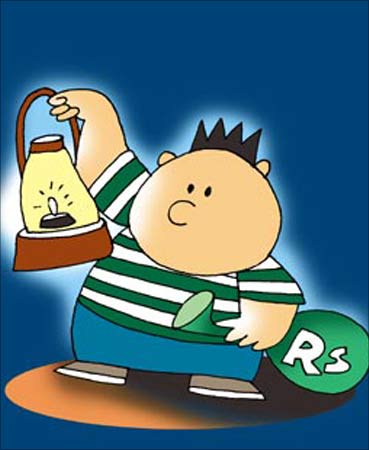
It is said that Indian batsmen are tigers at home. Why? Because on Indian pitches they just get on to the front foot and pulverize any bowling. But when they go abroad, they limply hang their bats outside the off stump and get out meekly to the moving ball.
This difference in performance is because of the differences between Indian pitches and those found outside Asia. The same skill set which works great on one type of pitches fails when applied to different pitches.
Another analogy is the difference between driving a great car on a smooth 6-lane highway, and on a small village road. The car is the same but the comfort and performance would be vastly different.
Similarly, if brilliant analysis is applied to the wrong stocks, you can't get right results.
[Excerpt from Ashwani Gujral's bestseller How to Make Money Trading Derivatives. Published by Vision Books]
(C ) All rights reserved.

Generally, there are two types of stock analyses prevalent in the markets: top down and bottom up.
Bottom Up analysis
Bottom up analysis consists of analysing each individual company based on its earnings, cash flow, growth prospects, a review of its balance sheets, profit and loss statement, etc., and is generally used by fundamental analysts and other market players who are hunting for value.
Such analysis is of little value to technical traders as it does not sufficiently position the odds in their favour. Hence they typically look at top down analysis.

Top Down analysis
The market's main trend plays an integral part in where any stock is headed. Just as a rising tide lifts all boats whether big or small, so too a rising market buoys up all stocks to a greater or lesser extent.
So it is the main trend of the market that a technical trader first seeks to figure out. Such an analyst next looks at the trend of the particular sector or industry, and only then comes the trend of a particular stock. This is how technicians view the market.
By identifying situations where all three -- namely, the market trend, the sector trend and the stock's trend -- are moving in the same direction, the odds of making money in the shortest possible time are the highest.
So traders need to first assess the market direction, and then the sector direction before taking trades in a leveraged market.

The methodology that I am about to explain below has a very simple premise:
All assets which attract money continue to attract money till they become very expensive. Conversely, all assets which lose investor interest continue to slide till they bottom out.
We can identify such sectors and stocks by using the indicator called rate of change, or ROC.
Thus as a trader with a month's view, if I could get a list of stocks sorted from highest to lowest in terms of ROC, it will give me the right list of stocks or futures to trade.

Rate of Change
Rate of change is a very simple technical indicator and is available in most proprietary trading software. ROC provides information regarding the change in the price of a stock in a given time period.
Stocks which have the highest rate of change are obviously the ones attracting the most amount of money. The stocks with the lowest rate of change are the ones which are either not attracting money, or money may even actually be deserting them.
One can add some more parameters, such as looking at stocks which are priced, say, over Rs 200 -- this reduces the chance of getting stuck in a stock which can be cornered and manipulated -- and those that have an average daily trading volume of at least one lakh (100,000) shares.

For a swing trader, the ROC parameter for the number of days can be 20, as a month has about 20 trading days. A medium-term trader can look at 60 as his ROC parameter, as he is trading a larger time frame.
Such medium-term traders, on the other hand, may actually be interested in buying stocks which seem to have completed their corrective phases, in which case they may want to use this list upside down.
Let's now see how this strategy works in practice.
The Indian market had a large correction when Nifty fell from 3,770 (May 2006) to 2,600 (June 2006), followed by a pullback rally in which Nifty bounced back to 3,200 before resuming its decline.
At that point we were anticipating a retest of 2,600. So we needed to look for stocks which were showing weakness. In case 2,900 held, we would've reassessed the situation.
In the fourth week of July 2006, the market had clearly formed distributive patterns between 3,770-3,380 on the Nifty, and then again at 3,200-2,900. Also we can see that the 50 DMA (daily moving average) was then about to cross and slip below the 200 DMA, clear signs that the market would soon be heading down.
The first quarter results were also then coming in. Technology, cement, metals, etc. turned in great results, actually better than what the market had expected. As each brilliant result was announced, the market, however, beat the stock down.

Since the market continued to sulk, it was sending out a message that it was looking at a possible earnings decline in future quarters as a result of rising interest rates and inflation. It's important not to react to results like a news channel does but like the market which, in its wisdom, tries to look ahead and drive while keeping an eye on the rear view mirror.
As noted earlier, at this point we needed candidates to sell. Accordingly, we generated a list of stocks, based on their ROC in descending order, from the futures and options segment using the above-listed parameters.
This methodology is similar to the relative strength methodology. Generally we look for the weakest stocks in a weak market, but when the markets are ready to break down we should also look at strong stocks which are beginning to weaken.
However, since many stocks had already lost a lot of ground it was important to identify stocks which still had room to decline further. I often start with the top 10 and bottom 10 stocks in such a list, but here let's review only the top 5 and bottom 5.
Another important piece of information that such a list gives us is about the sectors which are becoming stronger and those which are weakening. This key information helps me back strong or weak sectors.
All things being equal, I would rather buy a strong stock in a strong sector -- rather than a strong stock in a weak sector -- and short a weak stock in a weak sector.
[Excerpt from Ashwani Gujral's bestseller How to Make Money Trading Derivatives. Published by Vision Books]
(C ) All rights reserved.